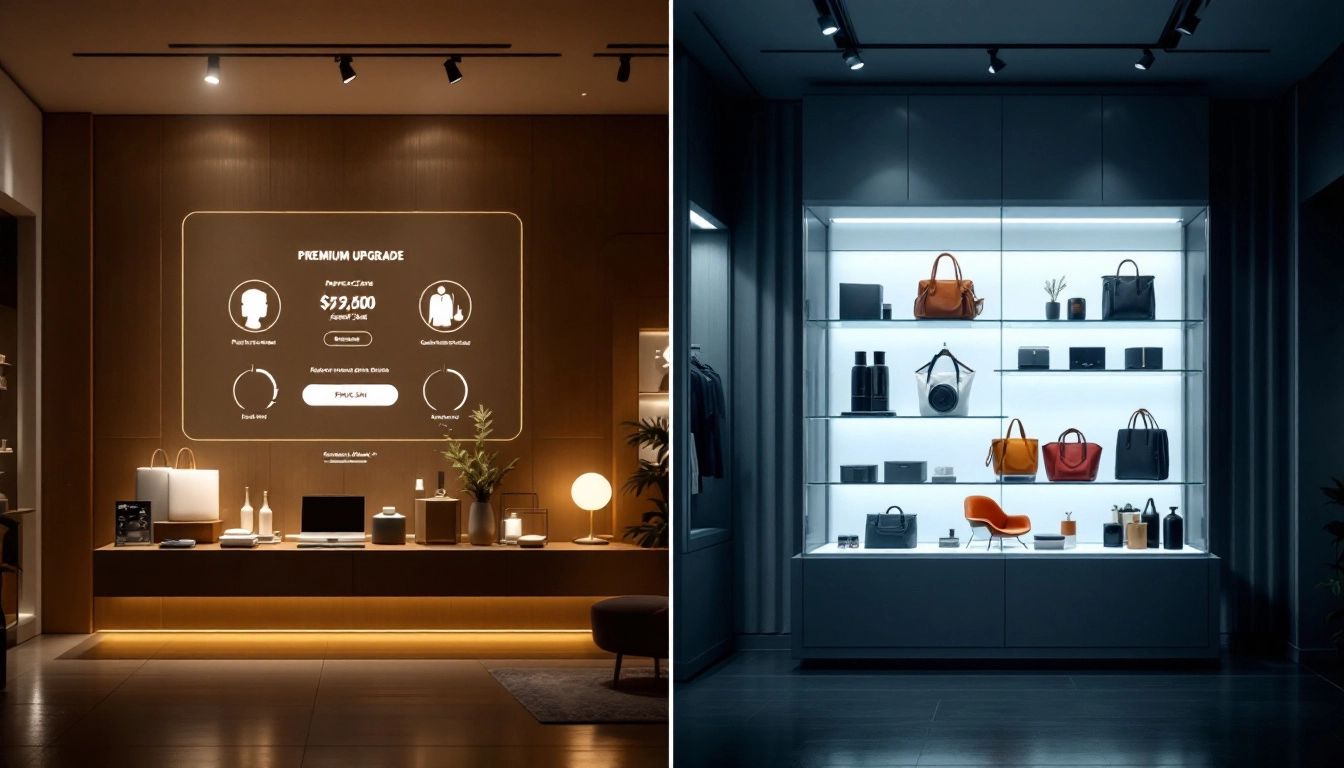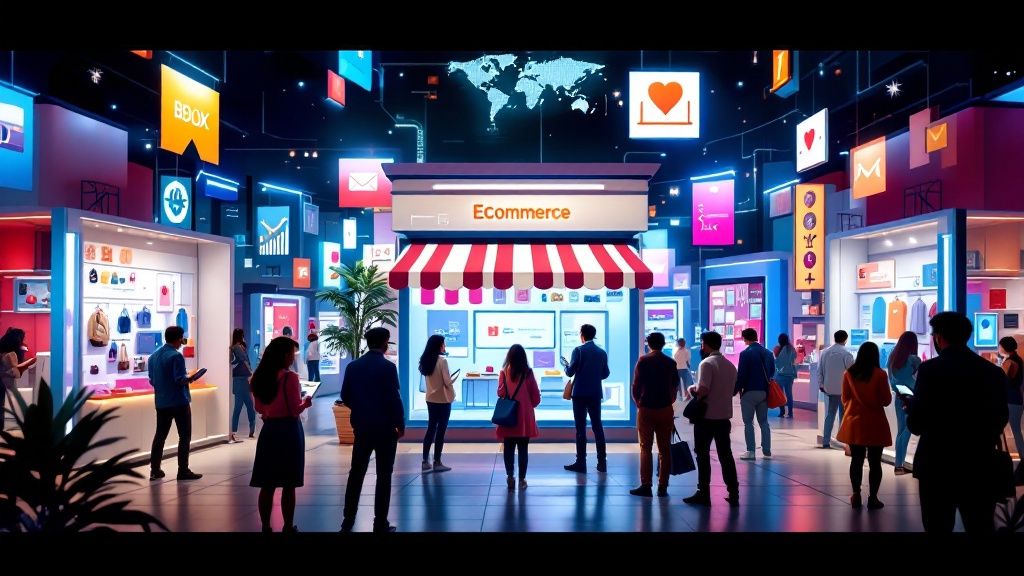Upselling vs. Cross-Selling: Spotting the Difference and Boosting Your Sales
November 2, 2024

Understanding Upselling and Cross-selling

Upselling and cross-selling are two important sales techniques that can dramatically improve your profits. While they are often mixed up, knowing the difference between them is crucial for getting the most out of them. Both aim to increase sales, but they do so in different ways. Think of them as two sides of the same coin, each with its unique advantages.
What is Upselling?
Upselling is about convincing a customer to buy a more expensive version of the product they are already looking at. This might be a larger size, a more advanced model, or a premium package with extra features. For example, a customer might be looking at a simple coffee maker. An upsell would be to suggest a model with a built-in grinder and milk frother, emphasizing the convenience and richer coffee experience. The goal is to increase the value of the single sale by offering a more valuable product.
What is Cross-selling?
Cross-selling means suggesting related products or services that enhance the original purchase. It's about finding things that naturally go together. Using the coffee maker example, cross-selling might involve recommending coffee filters, a travel mug, or some gourmet coffee beans. Cross-selling raises the total order value by adding more items to the shopping cart. This increases sales and creates a more complete and satisfying experience for the customer.
Think of a fast-food restaurant. When a customer orders a burger, the cashier usually asks, “Would you like fries and a drink with that?” That's cross-selling—offering related items to go with the burger. If the customer opts for a bigger burger with extra toppings, that's upselling.
Both strategies rely on knowing what customers need. Good upselling isn't about pushing the priciest option. It's about showing the added value of the upgrade. Similarly, good cross-selling requires offering relevant additions, not just tacking on extra items. Done right, both tactics boost revenue, improve customer satisfaction, and build stronger customer relationships. It's not about tricking customers, but about offering good options and improving the shopping experience.
Key Differences Between Upselling and Cross-selling

We've looked at upselling and cross-selling individually, but how do they compare? What's the core difference? Let's break down the key distinctions and examine how they work in real situations.
The Focus of the Sale
The fundamental difference is in what each technique tries to do. Upselling aims to raise the value of the single item purchased. It's about getting a better version of what the customer already wants. Cross-selling tries to raise the total order value by adding more items to the cart. It’s about complementing the first purchase, not changing it.
Timing is Everything
When these techniques are used is important too. Upselling usually happens just before a purchase is finished. Think about buying a flight online. Right before you click "buy," you may see the option to upgrade to a better seat with more legroom. That's upselling. Cross-selling can happen at different points, like during the purchase, at checkout, or even after the sale. An email suggesting accessories for a camera you recently bought? That's post-purchase cross-selling.
The Customer Perspective
How customers see these techniques can also vary. Successful upselling makes the customer feel like they're getting a good deal, improving their purchase. Bad upselling feels pushy. Effective cross-selling gives customers helpful additions and a complete solution, but poor cross-selling can feel like an onslaught of random offers. It’s all about providing relevant added value.
Real-World Examples: Upselling vs. Cross-selling
Let’s say you’re buying a laptop. If the salesperson suggests a model with a faster processor and more storage, that's upselling. If they recommend a laptop bag, a wireless mouse, and an extended warranty, that’s cross-selling.
Or imagine you're at a software-as-a-service (SaaS) website, looking at a basic subscription. The website displaying a premium subscription with extra features and benefits is upselling. If during checkout you're offered things like training sessions or integration with other tools, that's cross-selling.
Knowing these subtle yet important differences is crucial for maximizing revenue and customer satisfaction. Using them well can really help a business grow. For Shopify store owners, tools like Checkout Links offer simple integration for creating tailored shopping experiences with upsells and cross-sells, increasing average order values. When used strategically and ethically, both techniques become ways to give customers better value and a better overall experience.
Implementation Strategies
We understand the difference between upselling and cross-selling, but how do we put these strategies to work? Success depends on focusing on real value, not pushing unnecessary products.
Strategic Placement for Upselling
Upselling works best at key decision-making points. Think of the "upgrade your seat" prompt during online flight check-in. The customer is already committed but might want to improve their experience. Similarly, highlighting premium products just before they're added to an online cart can be effective. Software subscriptions often have tiered pricing plans with increasing features and benefits. The key is to make the upgrade appealing and show its value.
Contextual Relevance for Cross-selling
Cross-selling depends on understanding which products go together. A laptop bag with a laptop makes sense. Coffee filters with a coffee maker? Of course. But throwing random items at a customer will likely fail. The goal is to enhance the purchase, not make it confusing. This can be achieved with "frequently bought together" sections or tailored recommendations based on browsing history. Post-purchase emails can suggest accessories or related items.
Personalized Approaches
Imagine looking at running shoes online. You'd probably be more interested in an upgrade with better cushioning if it mentioned your need for arch support. Personalization matters. Tailoring suggestions based on data like purchase history, demographics, and browsing makes them more effective. This shows customers you understand their needs, building trust and improving their experience.
For Shopify users, tools like Checkout Links integrate directly, helping to create personalized experiences with upsells and cross-sells that boost average order values. This makes it easier to offer relevant products at the right time, improving both customer satisfaction and revenue. Whether you're highlighting a premium upgrade (upselling) or a complementary item (cross-selling), relevance and value are essential for success.
Benefits for Businesses

Using upselling and cross-selling strategies offers many benefits. Understanding how each contributes to these advantages is key. Both lead to higher profits and better customer relations.
Increased Revenue and Profitability
Upselling increases the value of each sale, while cross-selling raises the total order value. Together, they can significantly boost revenue. A customer planning to spend $50 might spend $75 or $100 with effective upselling or cross-selling. These small increases add up, contributing to higher profits.
Enhanced Customer Lifetime Value
Offering relevant upgrades and related products helps build better customer relationships. Happy customers are more likely to return, leading to a higher customer lifetime value (CLV)—more revenue from each customer over time.
Improved Customer Satisfaction
When done well, both strategies improve the customer experience. An upsell to a premium product can offer a better solution. A relevant cross-sell can save the customer time by providing everything they need at once. These positive interactions build trust and loyalty.
Stronger Customer Relationships
Personalized suggestions show customers you understand them. This strengthens the relationship. Customers who feel understood are more likely to return. This creates brand loyalty and positive word-of-mouth referrals.
For Shopify store owners, tools like Checkout Links simplify using these strategies directly within Shopify, boosting average order values and creating tailored shopping journeys. This avoids complex integrations and technical challenges. By offering suitable products at the right time, Shopify merchants can use upselling and cross-selling to boost customer satisfaction and revenue.
Common Mistakes to Avoid
It’s easy to make mistakes that can turn customers away when using these strategies. Knowing the difference between them is the first step, but knowing what not to do is just as vital.
Pushing Too Hard
Being too aggressive is a big mistake. Overwhelming customers with irrelevant offers will annoy them. If you're buying a phone, a case suggestion is fine, but if you're then flooded with offers for everything else, you'll likely feel overwhelmed. This leads to abandoned carts and damaged relationships. Focus on a few helpful suggestions—quality over quantity.
Ignoring Customer Needs
These tactics should always be customer-focused. Suggesting a premium product just because it’s pricier, without understanding the customer’s needs, will fail. Similarly, pushing irrelevant cross-sells to boost order value can backfire. If a customer is buying a basic laptop, a high-end gaming mouse probably isn't a good suggestion. Understand their needs and tailor your recommendations accordingly.
Poor Timing
When you present offers matters. Trying to upsell before a customer has even looked at the basic product is pushy. Overloading them with options at the beginning of checkout can be distracting. Find the right balance. Offer upgrades when a customer is customizing a product or checking their cart. Present cross-sells when they're looking at similar items or finishing their purchase.
Lack of Clarity
Keep offers clear and straightforward. Confusing language or complex bundles can put customers off. Clearly explain the benefits of each offer, highlighting the added value. Transparency builds trust. If you're offering a warranty, explain clearly what it covers. Don't hide details in fine print.
Neglecting the Mobile Experience
With much online shopping happening on mobile devices, ignoring this is a big mistake. Ensure your offers are clear and work seamlessly on smaller screens. Cluttered layouts or complicated menus lead to frustration and lost sales. Optimize your mobile site for a smooth user experience. A positive mobile experience means higher conversion rates and happier customers.
Real-world Examples

Let’s look at some real examples that show these strategies in action and their impact.
The Streaming Service Subscription
You’re signing up for a streaming service, choosing the basic plan for one device. At checkout, the website highlights the premium plan with 4K, multiple streams, and offline downloads, all for a bit more per month. That’s upselling—a better version of what you originally chose. Later, you get an email suggesting a sports package or a premium movie channel. That’s cross-selling—related services that add to your basic subscription.
The Furniture Store Experience
You’re buying a sofa. The salesperson shows a basic model, then a similar one with nicer fabric, comfier cushions, and a recliner. This is upselling—an upgrade to a more luxurious version. As you’re finalizing the purchase, they suggest a matching chair, coffee table, and throw pillows. That's cross-selling—complementary items to enhance your living room.
The Fast-Food Combo Meal
You order a single cheeseburger. The cashier asks, “Would you like to supersize that?” That’s upselling—a larger portion. Then, they ask, "Would you like fries and a drink?" This is cross-selling—adding items to make it a complete meal.
Software as a Service (SaaS)
Many SaaS businesses offer tiered subscriptions. You’re looking at a basic project management plan. The pricing page highlights the "Pro" plan with team tools, advanced reporting, and more storage. That’s upselling. At checkout, they offer add-ons like onboarding sessions, priority support, or software integrations. That's cross-selling.
These examples demonstrate how upselling and cross-selling work in different business models. From streaming and furniture to fast food and SaaS, understanding the difference between them is essential for boosting sales and improving customer experience. By offering relevant upgrades and additions, businesses can increase revenue while giving customers a more satisfying shopping journey. Checkout Links provide Shopify merchants with a useful tool to implement these strategies effectively, leading to higher average order values and a more personalized experience. Want to boost sales and make checkout better? Try Checkout Links today! Check it out here!
 Checkout Links
Checkout Links



